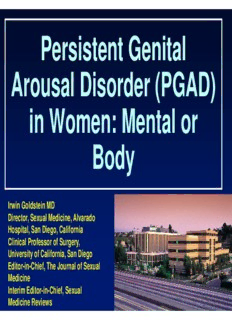
Persistent Genital Arousal Disorder (PGAD) in Women - Status Plus PDF
Preview Persistent Genital Arousal Disorder (PGAD) in Women - Status Plus
Persistent Genital Arousal Disorder (PGAD) in Women: Mental or Body Irwin Goldstein MD Director, Sexual Medicine, Alvarado Hospital, San Diego, California Clinical Professor of Surgery, University of California, San Diego Editor-in-Chief, The Journal of Sexual Medicine Interim Editor-in-Chief, Sexual Medicine Reviews Persistent Genital Arousal Disorder (PGAD) Persistent genital arousal disorder (PGAD) (formerly PSAS) is a rare, unwanted and intrusive sexual dysfunction associated with excessive and unremitting genital arousal and engorgement in the absence of sexual interest PGAD is extremely frustrating and can lead to suicidal ideation and attempts The persistent genital arousal usually does not resolve with orgasm Persistent Genital Arousal Disorder: during PGAD episode Homuncular genital representation Normal clitoris projection PGAD attack Increased Central sexual peripheral arousal reflex pudendal center that is nerve overly excited sensory and under afferent inhibited input Pain and Orgasm Share Common Neurologic Pathways – Lateral Spinothalamic Tract Pain and Orgasm Share Common Neurologic Pathways – Lateral Spinothalamic Tract The spinothalamic tract is a sensory pathway originating in the spinal cord The spinothalamic tract transmits afferent information to the thalamus about pain, temperature, itch and crude touch The types of sensory information transmitted via the spinothalamic tract are described as “affective sensation” - the sensation is accompanied by a compulsion to act. For instance, an itch is accompanied by a need to scratch, and a painful stimulus makes us want to withdraw from the pain Female Sexual Response Cycle Orgasm PGAD ????? = limited resolution of the genital arousal Plateau ………………………… (D) Excitement (B) A B C (C) (A) Adapted from Masters WH, Johnson VE. Human Sexual Inadequacy. Little Brown; 1970. 1. PGAD is not so rare—I personally have spoken with and/or cared for well over 100 women and men with PGAD. I have asked healthcare providers at numerous sexual meetings to raise their hands if they have cared for individuals with PGAD and under most situations, approaching 1 in 4 or 5 providers have managed such patients. 2. PGAD can be cured—We have several patients diagnosed with PGAD who are no longer suicidal or bothered/distressed after treatment(s). 3. 4. PGAD may be acquired later in life after living many years with no hint of PGAD symptoms. 5. PGAD can occur at a very young age; some people report persistent genital arousal all their lives and do not know any other form of sexual arousal. Persistent Genital Arousal Disorder (PGAD) Persistent Genital Arousal Disorder (PGAD) There are no recognized safe and effective evidence-based treatments Most physicians are uninformed and unaware of PGAD No animal models of PGAD yet exist Primary versus acquired Biopsychosocial pathophysiologies – Psychologic – especially STRESS Musculoskeletal Hormonal Vascular Neurological Pharmacologic Causes
Description: